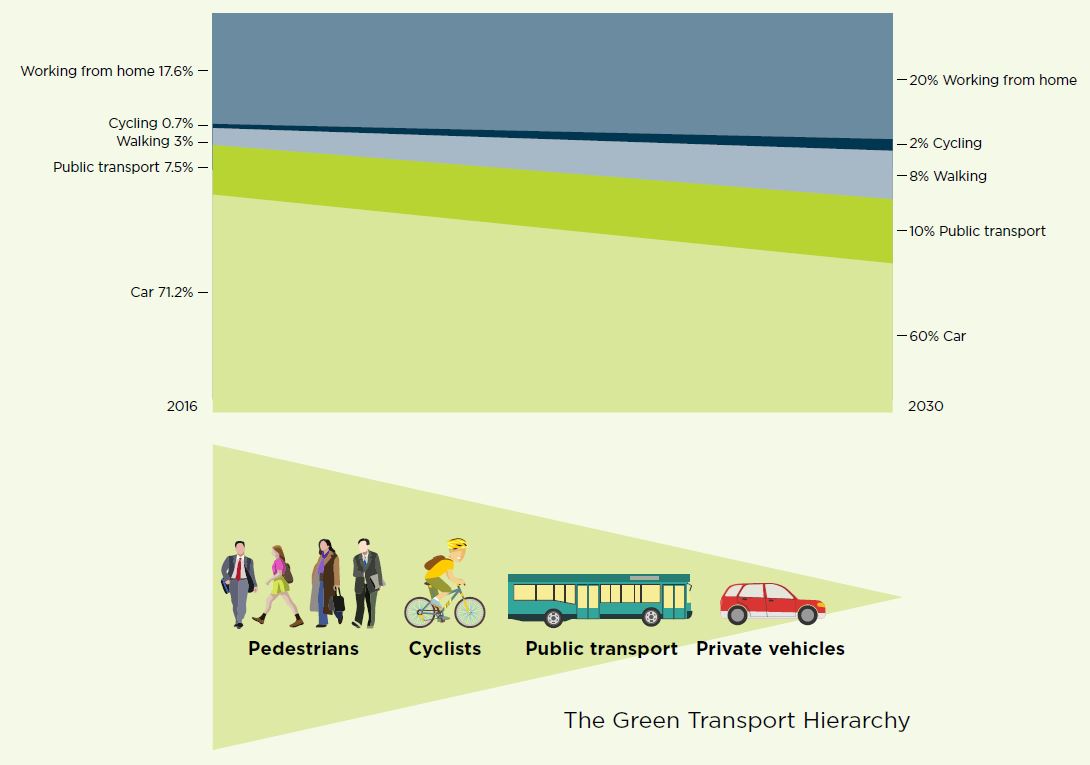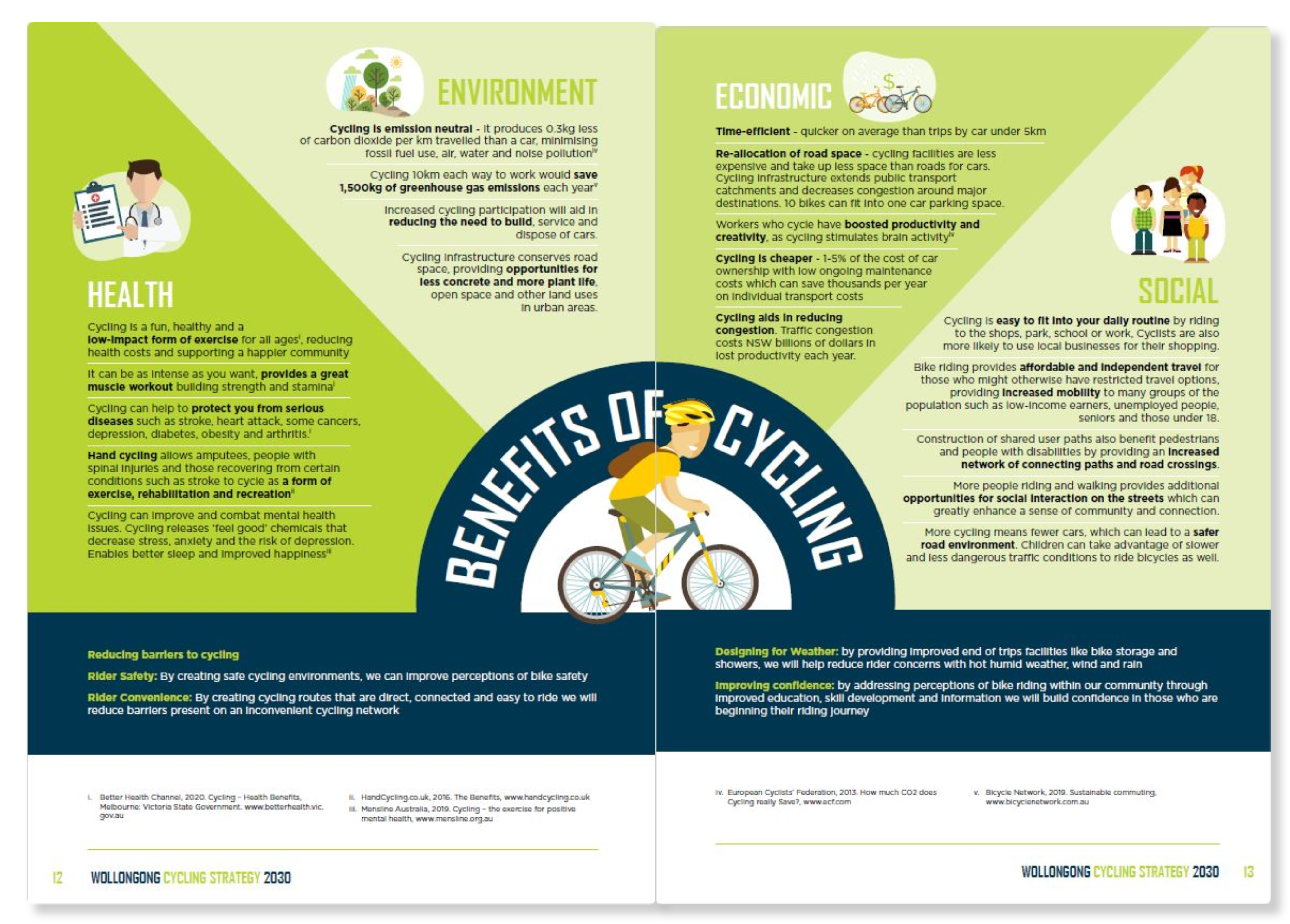
Wollongong Keeping the Cadence High for Cycling to Work
Behavioural change by residents is needed to achieve the NSW Governments’ transport vision as shared in the Illawarra-Shoalhaven Regional Transport Plan. According to the plan, only 10 per cent of all current trips are made by walking, cycling, or public transport. To meet the 20 per cent goal, we’ll need to double our efforts.
By 2041, we want to see one in every five (20 per cent) trips - be they work, education, health, retail, or recreation-related - made by walking, cycling, or public transport. Transport for NSW
The following factors will continue to increase travel demands on the roads within our region:
• In 20 years, an extra 100,000 people are expected in the region, adding 25 per cent more trips to our roads.
• 88 per cent of trips are taken wholly within our region (84 per cent) placing stress on our road network during peak periods.
• Housing growth, with 30,000 new homes expected in areas like West Lake Illawarra and Nowra-Bomaderry.
• Job growth and housing in the city centres of Wollongong, Shellharbour, Kiama, Nowra, and Milton-Ulladulla.
• Technology, Defence, industry, and commerce employment opportunities within:
-
- Port of Port Kembla
- Tallawarra
- South Nowra and Albatross Aviation and Tech Park
- Shellharbour Airport, Shellharbour Business Park and West Dapto.
• Almost 60 per cent of the freight moved through the Port of Port Kembla is moved by road, and freight volumes are increasing dramatically.
• Connectivity to a growing Western Sydney for employment, education, recreation, and freight transfer.
A low-emissions future is also a driver for change. The transport sector is the second largest contributor to greenhouse gas emissions in NSW, with electricity generation being the largest. The NSW Government has committed to a 30 per cent emissions reduction through their Net Zero Plan Stage 1: 2020-2030.
Wollongong City maintaining Pace with the Global Peleton
Wollongong City has an already impressive cycling network length of 130 km, and under the Wollongong Cycling Strategy 2030, this distance will be extended to 215 km by 2030. The strategy aims to rapidly expand the cycling network as quickly and safely as possible by pulling a myriad of levers to create cycling streets, mixed-traffic routes, re-allocation of road space in high-activity areas, more public bike racks, traffic light upgrades, and strengthening cycling links between the education corridor and city centre.
Earlier this year, the City of Wollongong was Australia’s first city to be declared a ‘Bike City‘ by the world governing body of cycling, the Union Cycliste Internationale (UCI); joining only 17 other bike cities laying claim to this prestigious title worldwide.
The purpose of the UCI Bike City Label is to not only recognise the elite cycling cities of the world, but to award cities or regions that aspire to become cycling cities and have invested in an outstanding long-term cycling strategy. Greg Doyle, Wollongong City Council, General Manager.
Shifting Gears to Performance Mode
Based on an assumption you made 20 trips in a private vehicle in one week (e.g. ten for work and ten for other reasons), then under the NSW goal, you’d need to replace four of these trips with walking, cycling, or public transport by 2041. Some of us at Blend ESQ hope to be retired by then, so let’s not wait 20 years!
Wollongong City Council is stepping up the challenge on this goal, and asking that of these ten work trips, you replace two of these with walking, cycling, or public transport by 2030, in nine years. Council’s Green Transport Hierarchy (page 9) provides a roadmap for the behavioural change we all need to make to ensure Wollongong continues to be a liveable and workable city. Council is making improvements to the cycling network so we can pedal our wait from 0.7 to 2 per cent of work trips made with the bike.

Mode Share Targets for Wollongong Journeys to Work by 2030, Wollongong City Council (2021)
The COVID-19 Factor
Wait a sec, wouldn’t lots of people be smashing ‘The Green Transport Hierarchy’ right now in the COVID-19 pandemic, with some office-based workers even scoring 100 per cent of work trip replacement by ‘working from home’. Sure would, about 30 per cent of Australia’s workforce (or four million people) had worked from home between March and November 2020 due to the pandemic, according to the L.E.K Consumer Survey prepared to inform the Infrastructure Australia December 2020 report: Infrastructure beyond COVID-19 – A national study on the impacts of the pandemic on Australia – An Interim Report for the 2021 Australian Infrastructure Plan. With additional lockdowns hitting NSW, VIC and SE QLD this year, this ‘working from home’ figure is likely much higher.
For those working from home: ‘maintaining relationships’, ‘increased collaboration’ and ‘undertaking tasks that cannot be done from home’ will see us return to the workplace according to the Transurban Industry Report, Urban Mobility Trends from COVID-19 (February 2021). However, it’s predicted with so many having establish their ‘home office’ during the pandemic, that we will return to a ‘hybrid structure’ with 42 per cent wishing to work from home once or more a week (Infrastructure Australia, November 2020).
With the continued risk of transmission of the Delta strain of COVID-19, survey data of existing daily public transport users in Sydney, showed that 20 per cent of them intended to use less public transport post-pandemic (Transurban, February 2021). With an increase in private vehicle use, it’s an opportune moment to push for an increase in cycling to get to and from work.
Promoting Active Transport in your Workplace
Business initiatives to promote active transport options (like walking, running, cycling, and scooting) together with initiatives that remove private vehicles from our roads (like working from home, public transport, and carpooling) can go a long way towards achieving the health and safety, well-being, environmental and sustainability objectives that you may have set as a business. Initiatives like these also help to resolve social problems like obesity, mental health, air quality, and greenhouse gas emissions.
Reducing the number of vehicles on the road may help your business to meet its commitments under:
• AS NZS ISO 14001 – Environmental Management Systems
• AS NZS ISO 45001 – Occupational Health and Safety Management Systems
• Sustainability Programs geared to achieve the 17 Global Sustainable Development Goals 2015 – 2030. Goals relevant to this article might include Goal 3: Good Health and Wellbeing, Goal 11: Sustainable Cities and Communities, and Goal 13: Climate Action
• Client or Tender requirements.
We recommended you get inspired by Wollongong City Council’s ‘Health, Environment, Economic and Social’ reasons to get on your bike, as summarised on pages 12 and 13 of the Wollongong Cycling Strategy 2030.

Benefits of Cycling, Wollongong Cycling Strategy 2030
So where’s the Start Line?
Talk to your workforce about their barriers for choosing walking, cycling, and public transport to get to and from work and individually plan to resolve these, where you can.
For example, most people (62 per cent) suggested it was ‘too far’ for them to cycle to and from work (community survey input into Wollongong Cycling Strategy 2030). Some possible options to explore could include:
- suggesting train or private vehicle travel for part of the journey
- offering to cover a one-off expense to pay for hiring an electric bike to make a longer ride possible
- encourage people to start work in their active gear, to allow a 30-minute cool-down before showering
- establishing an active lifestyle setting to business meetings i.e. no meetings before 10 am or after 4 pm to allow later starts or earlier finish times
- providing secure overnight bike storage to limit the need to make both trips on the same day via bike
- arrange a company workshop on bicycle maintenance, tyre repairs, and bike road rules
- offer a capped expense item to pay for front/rear lights, bike chain, portable repair kits, or bike servicing.
Be realistic, travel via bike might not be possible every day, week or month due to site works, meetings, the need to move equipment around, deadlines, daylight, and weather, etc. However, businesses that are serious about removing vehicles from the road, will be having regular conversations and planning for when the next cycling trip can occur.
Track Your Company Performance
Working on the basis of ‘what gets measured, gets improved’ you could create a workplace survey to track business progress towards Wollongong City Council’s 20% goal or compare business progress year on year as you push for walking, cycling, and public transport culture in your workplace.
One of many possible ways to run a commuter survey in your workplace would be to:
• Establish a data set that works for your workplace. Feel free to use our example in the image below, designed in Microsoft 365 Forms. Just duplicate travel ‘to work’ to capture ‘from work’ as well.
• Filter out the ‘leave’ and ‘non-work days’ and chart your progress. If you didn’t want to track this all year, take quarterly samples for February, May, August, and November.

Example of Workplace Commuter Survey. Designed by Blend ESQ using Microsoft 365 Forms.
Blend ESQ services the Illawarra and Sydney Surrounds and can assist you with your sustainability, environmental, health and safety, and well-being goals with our leading management systems advice. Safe and happy cycling!
Thanks goes to the following articles and sources who made this article possible:
Information Sources & Useful Links:
-
-
- Infrastructure Australia in collaboration with L.E.K Consulting, Infrastructure beyond COVID-19 – A national study on the impacts of the pandemic on Australia – An Interim Report for the 2021 Australian Infrastructure Plan, November 2020 (Federal Government and Consulting)
- NSW Government, Net Zero Plan Stage 1: 2020-2030, March 2020 (State Government)
- Transurban, Industry Report, Urban Mobility Trends from COVID-19, March 2021 (Road Operator)
- United Nations Department of Economic and Social Affairs (Division for Sustainable Development Goals), Sustainable Development Goals, 2015 (Global)
- Wollongong City Council, Wollongong Cycling Strategy 2030, April 2021 (Local Government)
- Wollongong City Council, Wollongong goes international with Bike City Label recognition, February 2021 (Local Government News).
-
Graphics/ Photography credits:

